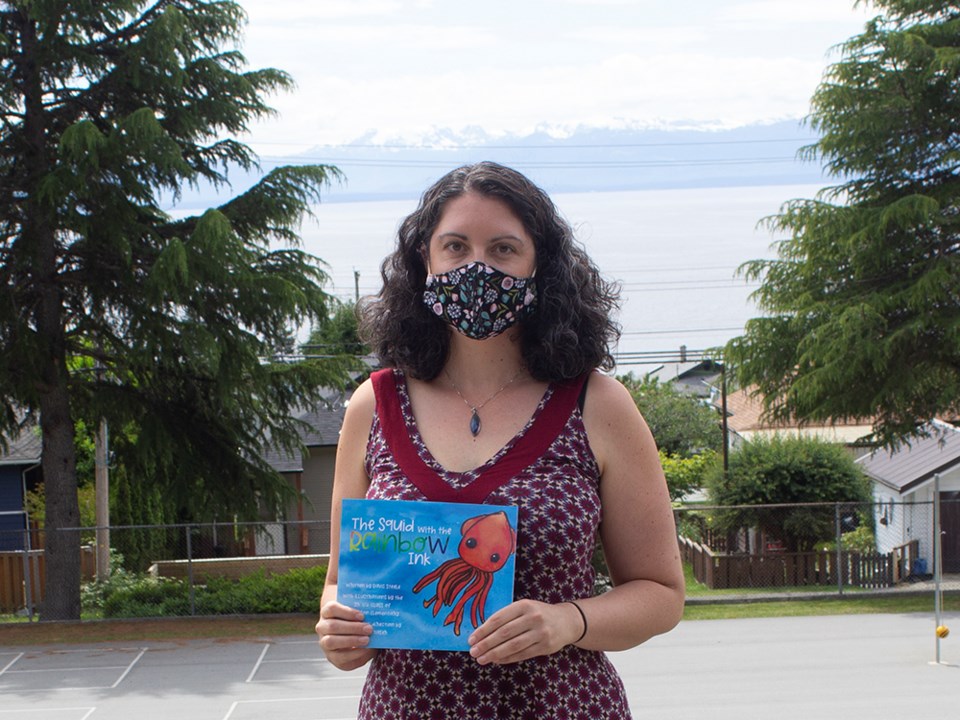Grade one and two students at Henderson Elementary School have published their very first book, employing artistic techniques taught by teacher Megan Fraser to bring to life an original story authored by teacher Davis Steele.
The Squid with the Rainbow Ink tells the story of Kai, a squid with gender-neutral pronouns, who shoots rainbow-coloured ink instead of black. At first, Kai’s teacher, parents and classmates – with the exception of Kai’s friend, Ali – disapprove of the rainbow ink, leaving poor Kai feeling that they must change.
Eventually, however, the other squid realize their black ink stands out vividly next to Kai’s beautiful rainbow colours. The squid celebrate Kai’s uniqueness, and Kai realizes they must never try to change who they are.
Steele began writing the story as a personal creative project, but as the concept behind the story developed, he quickly saw its potential as an educational resource, and approached Fraser and her class to bring the tale to life with original illustrations.
“It kind of became collaborative after that,” said Steele.
It’s a simple story with the potential to be read in different ways, explained Steele. The part when Kai tries to change their ink, for example, indirectly broaches the topic of conversion therapy, an abusive and scientifically discredited practice that seeks to change a person’s sexuality or gender identity.
While that heavy theme might not be fully understood by younger students, explained Steele, the book also has the potential to serve as a learning resource in high school classrooms.
“It kind of opens it up to have that conversation with the older kids, and so I kept it in, because I was thinking maybe a high school teacher wants to use this book, and that’s something you can dig into if you’re doing a social justice class,” said Steele. “I wanted it to have a wider audience than just elementary school.”
Steele, who teaches kindergarten through grade seven, said groups of students have so far responded to the story in different ways. Some, he explained, are simply thrilled about the fact that their teacher is an author, and are keen to share their own stories.
With some classes, Steele asks students to imagine how they might feel in Kai’s situation.
“Sometimes it’s, ‘I’d feel very scared; I’d feel very sad,’ and then other times it goes into a place of great pride, and I think both of them are valid,” explained Steele.
Sometimes, he added, conversations with students are not about the story’s diversity message at all, and go in completely different directions.
“That’s the great thing about working with kids, and opening up conversations, because they’ll really pull whatever they want out of the book,” said Steele.
Some students are keen to learn about the publishing process itself, something Steele himself is new to. The book, he explained, was published using an app from a website called Blurb with the required funds provided by School District 47’s Sexual Orientation and Gender Identity (SOGI) committee.
Each student who participated in the project received a copy of the book, and additional copies will be gifted to all public schools in the district.
“I like the fact that it’s going to be small and in the community, and I like that the students were a part of it,” said Steele. “That’s way more meaningful than having it published widely.
“I just really want to thank the kids for all their hard work, and how much care they took about the topic and the actual work of publishing the book, and also Megan Fraser, because she put so much of her own time into it, and it’s a really special story to me.”
Watercolours illustrate story
Fraser said her class used watercolours to illustrate the story.
“[The students] thought that made sense because it was in the ocean, and kind of incorporated a lot of the techniques that we’d learned in other art projects throughout the year,” said Fraser.
Each student drew a squid, and Steele, said Fraser, picked the one he felt best reflected Kai’s character.
The students painted the backgrounds using a wet-on-wet watercolour technique, and used watercolour pens, which allow more control over colours, to draw features in the illustrations. The characters were then cut out and arranged in a collage.
The most visually captivating aspect of the illustrations, however, is the marble effect used to portray Kai’s rainbow ink.
“We tried a few different techniques for the marbling,” explained Fraser. “One we did was using eye-droppers to drop water colours onto shaving cream, and then to the paper, which was pretty neat, but it wasn’t as vibrant as what we were hoping for.”
The students settled on using crayola markers on coffee filters, and then spraying the filters with a water bottle.
“That creates the marbling, because all the colours kind of bleed out together,” said Fraser.
Fraser said her students didn’t need any time at all to process Kai’s gender-neutral pronouns, and that they identified not only with Kai, but also with Kai’s friend, Ali.
“This happens to be a very loving and inclusive class, and there are a number of kids who have diverse needs, and the class is incredibly supportive of them, and accepting of them, so I think they related on a number of levels,” said Fraser.
The project, she explained, combined artistic skills with lessons about diversity and inclusivity.
“Most of the art that we do in my class is very connected to something that we’re learning about, so it’s meaningful to the kids as opposed to a one-off craft type of thing,” said Fraser. “I don’t really see [art and social lessons] as being separate. It’s both.”
The illustration and editing process took around one month, and the book was printed at the end of May, said Fraser.
Asked if the book’s publication was deliberately timed for Pride Month, Fraser said, “It’s a happy coincidence.”



